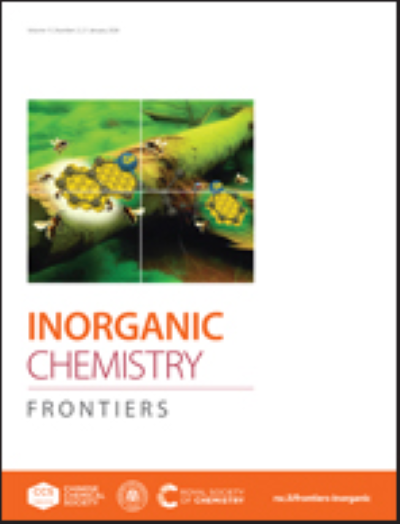New Encapsulated bis Cyclometalated Ir(III) Complexes with Very Potent Anticancer PDT Activity
IF 6.4
1区 化学
Q1 CHEMISTRY, INORGANIC & NUCLEAR
引用次数: 0
Abstract
Photodynamic therapy (PDT) has emerged as a promising approach to cancer treatment, due to its ability to reduce side effects. In the search for luminescent iridium [Ir(C^N)2(N^N)]+ complexes with high ability to generate ROS (reactive oxygen species) under irradiation, we employed C^N ligands with high π-expansion (pbpz (4,9,14-triazadibenzo[a,c]anthracene), 1, or pbpn (4,9,16-triazadibenzo[a,c]naphthacene), 3) that should lead to long excited state lifetimes. The photophysical properties were significantly influenced by the degree of C^N ligand π-expansion. Complex 1 exhibited a long fluorescence lifetime, matching the triplet lifetime observed in TAS, indicating delayed fluorescence. In contrast, the additional ring in complex 3 generated two near-HOMO orbitals, increasing the excited states LC character and reducing spin-orbit coupling (SOC) and intersystem crossing (ISC). They exhibited a notable ability to generate 1O2 and O2•−. TD-DFT studies nicely explained the differentiated photophysical properties. Both complexes exhibited significant phototoxicity against human cancer cells in both monolayer and multicellular spheroids models, with complex 1 exhibiting higher effect. They effectively photogenerated intracellular ROS, including O2•−. The mitochondrial accumulation of 1 and its disruption of mitochondrial functions was verified. Wound healing and clonogenic assays demonstrated their potential as antimetastatic agents. In general, complexes encapsulation significantly facilitated their cellular accumulation and increased photocytotoxic indexes, with NP1 achieving one of the highest IC50 reported in iridium chemistry. Furthermore, the NP showed good anticancer activity even in 3D models. Thus, 1 and 3 and specially NP1 show great promise as type I and II PDT agents with theragnostic potential.新型包封双环金属化Ir(III)配合物具有非常有效的抗癌PDT活性
光动力疗法(PDT)由于其减少副作用的能力而成为一种很有前途的癌症治疗方法。为了寻找在辐照下产生活性氧(ROS)能力强的发光铱[Ir(C^N)2(N^N)]+配合物,我们采用了具有高π膨胀的C^N配体(pbpz(4,9,14-三氮二苯并[a, C]蒽),1或pbpn(4,9,16-三氮二苯并[a, C]萘),3),这些配体应该会导致长激发态寿命。C^N配体π展开度对其光物理性质有显著影响。配合物1表现出较长的荧光寿命,与TAS中观察到的三重态寿命相匹配,表明荧光延迟。相反,配合物3中的附加环产生了两个近homo轨道,增加了激发态LC特征,降低了自旋轨道耦合(SOC)和系统间交叉(ISC)。它们具有显著的生成1O2和O2•−的能力。TD-DFT研究很好地解释了不同的光物理性质。在单层和多细胞球体模型中,这两种配合物对人癌细胞都表现出明显的光毒性,其中配合物1的作用更高。它们有效地产生细胞内ROS,包括O2•−。证实了1的线粒体积累及其对线粒体功能的破坏。伤口愈合和克隆实验证明了它们作为抗转移药物的潜力。总的来说,配合物包封显著促进了它们的细胞积累,增加了光细胞毒性指数,其中NP1达到了铱化学中报道的最高IC50之一。此外,即使在3D模型中,NP也显示出良好的抗癌活性。因此,1和3,特别是NP1作为I型和II型PDT药物具有很大的治疗潜力。
本文章由计算机程序翻译,如有差异,请以英文原文为准。
求助全文
约1分钟内获得全文
求助全文
来源期刊

Inorganic Chemistry Frontiers
CHEMISTRY, INORGANIC & NUCLEAR-
CiteScore
10.40
自引率
7.10%
发文量
587
审稿时长
1.2 months
期刊介绍:
The international, high quality journal for interdisciplinary research between inorganic chemistry and related subjects
 求助内容:
求助内容: 应助结果提醒方式:
应助结果提醒方式:


